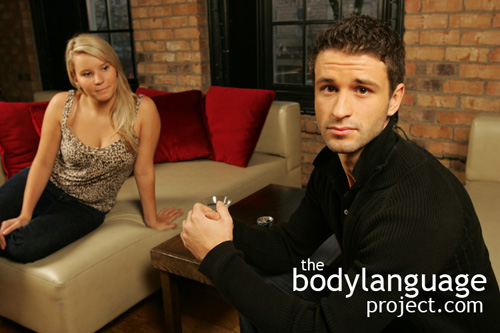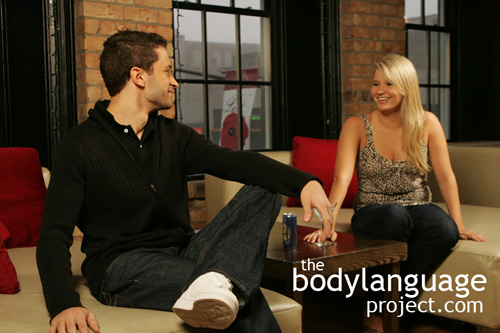Body Language of Hand Clasping
Synonym(s): Folded Hands, Clasping Hands, Self Clasping Hands, Hands Holding Hands, Clasping The Hands.
Description: Done by placing one hand inside the other, holding the hands together or cupping them together.
In One Sentence: Clasping the hands together is a signal of insecurity and represents a need to be pacified.
How To Use it: Clasp the hands together when you feel that you need to create a reassuring feeling. This can be done inconspicuously by placing the hands under the table on the lap. Clasping the hands on a desk is more visible, but generally goes unnoticed by people and is misread as proper, casual and in control. However, hands together, instead, is a way that most people create positive soothing feelings. When we hold our own hands, it simulate holding a parent’s or loved one’s hand and therefore creates an comforting feeling.
Context: General.
Verbal Translation: “I’m holding my hands together because I need to feel protected as if my Mom was holding my hand. While doing this, I’m not yet ready to participate in the discussion.”
Variant: See Fig Leaf Posture (The), Interlaced Fingers.
Cue In Action: During a business meeting, she held her hands on her lap cupped together. When she finally released her hands and added to the conversation, they knew she had finally welcomed the company strategy.
Meaning and/or Motivation: Clasping the hands together signifies a need for pacifying as it reminds us of our childhood when parents would have clasped the hand of their infant.
A person who uses the posture indicates shows doubt, low confidence, or that they are experiencing high stress. As tension escalates, the gesture will move from palm stroking into more rigorous interlaced finger stroking making the two a progression of intensity.
Alternatively, when the hands are unclasped it indicates that a person is ready to address the audience or someone else.
Cue Cluster: Clasped hands will show a reserved disposition. The person will lean back rather than toward, will be quiet and will be observing but not participating.
Body Language Category: Barriers, Body cross, Blocking or Shielding, Clenching and gripping, Closed body language, Defensive, Disengagement, Low confidence hand displays.
Resources:
Borenstein, Lynn. The development of friendship in childhood: A clinical conversation. Child and Adolescent Social Work Journal. 1996. 13(3): 213-224.
Bodie, Grahamd. ; Villaume, Williama. Men and Women Holding Hands Revisited: Effects of Mutual Engagement and Hand Dominance on Attributions of Cross-Sex Handholding. Communication Research Reports. 2008. 25(4): 243-254.
Bouras, N. ; Dykens, E. M. ; Smith, A. C. M. Distinctiveness and correlates of maladaptive behaviour in children and adolescents with Smith–Magenis syndrome
Journal of Intellectual Disability Research. 1998. 42(6): 481-489.
Barroso, Felix ; Feld, Jason. Self-touching and attentional processes: The role of task difficulty, selection stage, and sex differences. Journal of Nonverbal Behavior. 1986. 10(1): 51-64.
Butzen, Nathan David ; Bissonnette, Victor ; Mcbrayer, Dan. Effects of modeling and topic stimulus on self-referent touching. Perceptual and motor skills. 2005. 101(2): 413-20.
Broome, Marion E.. Helping Parents Support Their Child In Pain. Pediatric Nursing. 2000. 26(3): 315.
Bornstein, Marc H. ; Tamis-Lemonda, Catherine S. Maternal responsiveness and infant mental abilities: Specific predictive relations. Infant Behavior and Development. 1997. 20(3): 283-296.
Buckley, V., & Semple, S. (2012). Evidence that displacement activities facilitate behavioural transitions in ring-tailed lemurs. Behavioural Processes, 90, 433–435.
Bouhuys, A.L. ; Jansen, C.J. ; van den Hoofdakker, R.H. Analysis of observed behaviors displayed by depressed patients during a clinical interview: relationships between behavioral factors and clinical concepts of activation. Journal of Affective Disorders. 1991. 21(2): 79-88.
Bouhuys, A.L. ; Beersma, Domien G.M. ; van den Hoofdakker, Rutger H. Observed behavior as a predictor of the response to sleep deprivation in depressed patients. Psychiatry Research. 1989. 28(1): 47-61.
Berridge CW,Mitton E, ClarkW, Roth RH. 1999. Engagement in a non-escape (displacement) behavior elicits a selective and lateralized suppression of frontal cortical dopaminergic utilization in stress. Synapse 32:187–197.
Caplovitz Barrett, Karen. The origins of social emotions and self-regulation in toddlerhood: New evidence. Cognition & Emotion. 2005. 19(7): 953-979.
Chapell, M ; Basso, E ; Decola, A ; Hossack, J ; Keebler, J ; Marm, J ; Reed, B ; Webster, E ; Yoggev, D. Men and women holding hands: whose hand is uppermost?
Perceptual and motor skills. 1998. 87(1):127-30
Cowen, Emory L. ; Weissberg, Roger P. ; Lotyczewski, Bohdan S. Garfield, Sol L. (editor). Physical contact in interactions between clinicians and young children. Journal of Consulting and Clinical Psychology. 1983. 51(1): 132-138.
D’alessio, M. ; Zazzetta, A. Development of Self-Touching Behavior in Childhood. Perceptual and Motor Skills. 1986. 63(1): 243-253.
DeSteno, D.; Breazeal, C.; Frank, R. H.; Pizarro, D.; Baumann, J.; Dickens, L, and Lee, J. Detecting the Trustworthiness of Novel Partners in Economic Exchange. Psychological Science. 2012. 23, 1549-1556.
http://bodylanguageproject.com/articles/use-body-language-cues-create-trust
Flores, Luis E. ; Berenbaum, Howard. Desire for emotional closeness moderates the effectiveness of the social regulation of emotion. Personality and Individual Differences
Gulledge, Andrewk. ; Gulledge, Michelleh. ; Stahmannn, Robertf.. Romantic Physical Affection Types and Relationship Satisfaction. The American Journal of Family Therapy. 2003. 31(4): 233-242.
Gulledge, Andrew K ; Stahmann, Robert F ; Wilson, Colwick M. Seven types of nonsexual romantic physical affection among Brigham young university students. Psychological reports. 2004. 95(2): 609-14.
Goldberg, Shelly ; Rosenthal, Robert. Self-touching behavior in the job interview: Antecedents and consequences. Journal of Nonverbal Behavior. 1986. 10(1): 65-80.
Hernandez-Reif, Maria ; Diego, Miguel ; Field, Tiffany. Preterm infants show reduced stress behaviors and activity after 5 days of massage therapy. Infant Behavior and Development. 2007. 30(4): 557-561.
Harrison, Lynda Law. The use of comforting touch and massage to reduce stress for preterm infants in the neonatal intensive care unit. Newborn and Infant Nursing Reviews. 2001. 1(4): 235-241.
Hung, Iris W. and Aparna A. Labroo. From Firm Muscles to Firm Willpower: Understanding the Role of Embodied Cognition in Self-Regulation. Journal of Consumer Research. 2011 37(6): 1046-1064. http://www.jstor.org/stable/10.1086/657240
http://bodylanguageproject.com/articles/firm-muscles-lead-willpower/
Heaven, Laura ; Mcbrayer, Dan ; Prince, Bob. Role of sex in externally motivated self-touching gestures. Perceptual and motor skills. 2002. 95(1): 289-94.
Heaven, L ; Mcbrayer, D. External motivators of self-touching behavior. Perceptual and motor skills. 2000. 90(1): 338-42.
Kochanska, G., Coy, K. C., & Murray, K. T. (2001). The development of self-regulation in the first four years of life. Child Development, 72, 1091–1111.
Kochanska, G., Murray, K. T., & Harlan, E. T. (2000). Effortful control in early childhood: Continuity and change, antecedents, and implications for social development. Developmental Psychology, 36, 220–232.
Katza, Carmit; Irit Hershkowitz; Lindsay C. Malloya; Michael E. Lamba; Armita Atabakia and Sabine Spindlera. Non-Verbal Behavior of Children Who Disclose or do not Disclose Child Abuse in Investigative Interviews. Child Abuse & Neglect. 2012. 36: 12-20.
http://bodylanguageproject.com/articles/reading-nonverbal-behaviour-child-abuse-cases-encourage-children-divulge-information-truth-telling
Moore, Monica. Courtship Signaling and Adolescents: Girls Just Wanna Have Fun. Journal of Sex Research. 1995. 32(4): 319-328.
http://bodylanguageproject.com/articles/girls-just-want-to-have-fun-the-origins-of-courtship-cues-in-girls-and-women/
Mohiyeddini, Changiz ; Semple, Stuart. Displacement behaviour regulates the experience of stress in men. Stress. 2013. 16(2): 163-171.
Mohiyeddini, C., Bauer, S., & Semple, S. (2013a). Displacement behaviour is associated with reduced stress levels among men but not women. PLoS One, 8, e56355.
Mohiyeddini, C., Bauer, S., & Semple, S. (2013b). Public self-consciousness moderates the link between displacement behaviour and experience of stress in women. Stress, 16, 384–392.
Navarro, Joe. 2008. What Every BODY is Saying: An Ex-FBI Agent’s Guide to Speed-Reading People. William Morrow Paperbacks.
O’sullivan, Lucia F. ; Cheng, Mariah Mantsun ; Harris, Kathleen Mullan ; Brooks-gunn, Jeanne. I Wanna Hold Your Hand: The Progression of Social, Romantic and Sexual Events in Adolescent Relationships. Perspectives on Sexual and Reproductive Health. 2007. 39(2): 100-107.
Pettijohn, Terry F. , Ii ; Ahmed, Shujaat F. ; Dunlap, Audrey V. ; Dickey, Lauren N. Who’s got the upper hand? Hand holding behaviors among romantic couples and families.(Report). Current Psychology. 2013. 32(3): 217(4).
Rosenbloom, Tova ; Ben-Eliyahu, Adar ; Nemrodov, Dan. Children’s crossing behavior with an accompanying adult. Safety Science. 2008. 46(8): 1248-1254.
Rubin, Mark Morrison, Todd G. (editor). Social Affiliation Cues Prime Help-Seeking Intentions. Canadian Journal of Behavioural Science/Revue canadienne des sciences du comportement. 2011. 43(2): 138-141.
Toronto, Ellen L.K. A clinician’s response to physical touch in the psychoanalytic setting. International Journal of Psychotherapy. 2002 7(1): 69-81.
Troisi A. 1999. Ethological research in clinical psychiatry: the study of nonverbal behaviour during interviews. Neurosci Biobehav Rev 23:905–913.
Troisi A. 2002. Displacement activities as a behavioral measure of stress in nonhuman primates and human subjects. Stress 5: 47–54.
Vannorsdall, Tracy ; Dahlquist, Lynnda ; Shroff Pendley, Jennifer ; Power, Thomas. The Relation Between Nonessential Touch and Children’s Distress During Lumbar Punctures. Children’s Health Care. 2004. 33(4): 299-315.
Williams, Trish ; Connolly, Jennifer ; Cribbie, Robert. Light and Heavy Heterosexual Activities of Young Canadian Adolescents: Normative Patterns and Differential Predictors.(Author abstract)(Report). Journal of Research on Adolescence. 2008. 18(1): 145(28).





